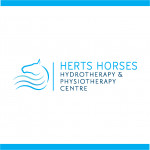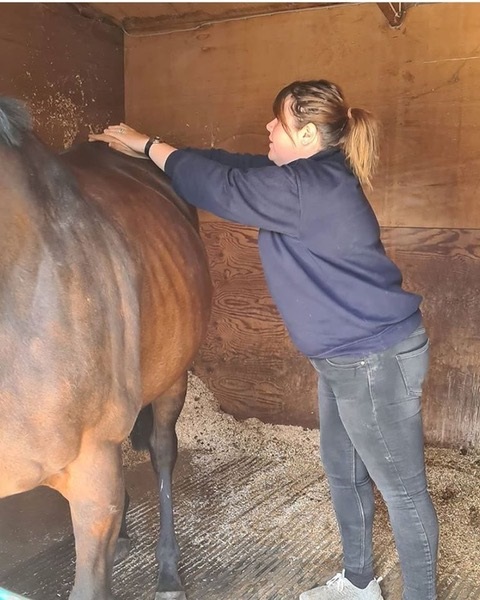Posted: 27th May 2020 | Back to news feed

At-home equine massage techniques to ease stiffness and discomfort in your horse’s back and pelvic region
Now that the lockdown restrictions are beginning to be eased, what are you hoping to do with your horse? Perhaps it’s time to bring them back into work after a little holiday or, if you’ve kept them in work for the past two months, it’s time to ramp things back up. Either way, the enforced change in routine may well have triggered or uncovered some back pain in your horse, which means you’re on the hunt for some at-home techniques to help. Let’s hear from Jessica Scranage, who heads up the team at Herts Horses Hydrotherapy & Physiotherapy Centre, about the most common issue she’s asked about and what you can do.

“Whether we’re able to get out and compete before the end of the summer is still up in the air, but I have been receiving lots of calls and messages during lockdown from people who felt their horses were exhibiting back stiffness, in particular discomfort through lumbosacral region and down into the gluteal muscles. Perhaps you’ve noticed your horse is looking stiff or uncomfortable after some time off? It’s worth thinking about what might happen to you if you went from being very active to barely doing any exercise. Unless you’re a spring chicken you would probably feel lethargic and sore, with little niggles coming to the surface! Maybe you’ve felt there has been some underlying soreness for a while and now is a good time to try something to ease it.”
“I believe that the back is the middle of a ‘chain’ in equines which has three links - the front end, the core and the hindquarters. Because of this chain effect, pain from one area of the body can impact the back and vice versa, and it isn’t always straightforward to identify what has caused the pain. If you suspect your horse is injured and very sore, make sure you call in a professional, but for stiffness and mild discomfort I’m happy to help owners with some massage techniques to try. These have been incredibly popular during lockdown and while it’s been harder for specialists to visit your yard. It’s worth trying these even if your horse appears perfectly well, as there are multiple benefits to massage, including increasing the circulation to muscles and building a great bond between you and your horse”
“Make sure your horse is warm before you begin – that might mean popping a fleece rug on them for a bit or standing them in the sunshine. I then begin with effleurage to warm up the muscles. Effleurage is repeated, gentle circular motions with the palm of your hand and its perfect to kick off with, as you don’t want to start with too much pressure. Begin either side of the whither, running your palms steadily but gently along the back to the area behind the saddle. After a few minutes of that, start to slowly build up the pressure. Remember to repeat everything you do on both sides of the back.”
“Then, move to vertical strokes behind the shoulder from bottom to top, working your way backwards along the ribcage, pushing upwards to the saddle area. You might feel knots or spasms as you work your way along. Try to release these gently with consistent sweeping pressure – don’t poke or niggle at them. If the horse is moving away, showing discomfort or dipping its back then make sure you listen to them. Try a lighter touch or move your hands a little slower. If they are showing signs of pain, then please stop and call in a specialist.”
“Next work towards the hindquarters, starting with effleurage and then using a higher-pressure circular motion and releasing the muscles running from the sacroiliac joint (that’s the ‘jumpers bump’ you can see) towards the tail. You might be able to feel where there’s some tightness and tension, which hopefully will ease.
Then massage the buttocks from the tail height to the quarters and observe any tightness in the muscle groups of the hind end. Finally, gently rotate the tail both ways – it’s an extension of the vertebrae so observing how a horse carries its tail or resistance to having it moved it can uncover some back issues. I normally work on soft tissue massage for half an hour to 40 minutes, but you will get a feel for which areas you need to focus on more and how long it takes.”
To watch the full video for yourself, head over to the Herts Horses Hydrotherapy & Physiotherapy Centre Facebook page. There are tips to help you keep your horse comfortable as well as insightful posts about the benefits of different schooling exercises from a physiotherapy and therapeutic point of view.
Remember, if you suspect your horse is injured and very sore, make sure you call in a professional. The team Herts Horses Hydrotherapy and Physiotherapy Centre are all educated to Masters’ level in Veterinary Physiotherapy for Equines and Canines and serve a varied client base of horses and dogs from the Hertfordshire, Bedfordshire, Buckinghamshire and London areas.
The Equestrian Index newsfeed is compiled from articles submitted by advertising members and expresses the opinions of those members. Watsons Directories Ltd shall not be held liable for any inaccuracies or mis-statements therein.